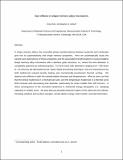Size effects in shape memory alloy microwires
Author(s)
Chen, Ying; Schuh, Christopher A.
DownloadSchuh_Size effects.pdf (1.708Mb)
PUBLISHER_CC
Publisher with Creative Commons License
Creative Commons Attribution
Terms of use
Metadata
Show full item recordAbstract
In shape memory alloys, the reversible phase transformations between austenite and martensite give rise to superelasticity and shape memory properties. Here we systematically study the sample size dependence of these properties and the associated transformations in polycrystalline shape memory alloy microwires with a bamboo grain structure, i.e. where the wire diameter is completely spanned by individual grains. Cu–Al–Ni wires with diameters ranging from ∼500 down to ∼20 μm are fabricated by the Taylor liquid processing technique, and are characterized by both isothermal uniaxial tensile testing and mechanically constrained thermal cycling. We observe size effects in both the transformation stresses and temperatures. What is more, we find that the stress hysteresis in a mechanical cycle and the temperature hysteresis in a thermal cycle both increase with decreasing wire diameter, particularly for wires smaller than 100 μm. A direct consequence of the increased hysteresis is enhanced energy dissipation (i.e. damping capacity) in smaller wires. We also discuss possible physical origins of the observed size effects, including interface and surface energies, stored elastic energy, heat transfer and internal friction.
Date issued
2010-10Department
Massachusetts Institute of Technology. Department of Materials Science and EngineeringJournal
Acta Materialia
Publisher
Elsevier
Citation
Chen, Ying, and Christopher A. Schuh. “Size Effects in Shape Memory Alloy Microwires.” Acta Materialia 59, no. 2 (January 2011): 537–553.
Version: Author's final manuscript
ISSN
13596454
1873-2453